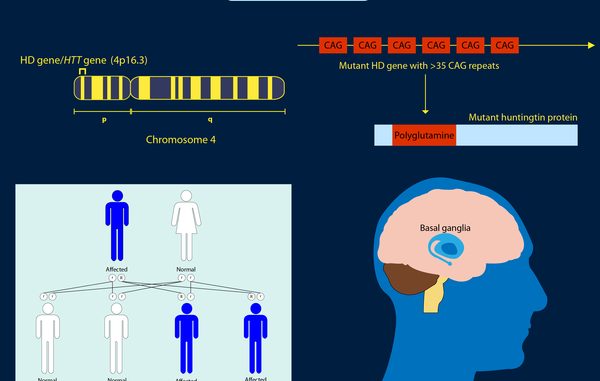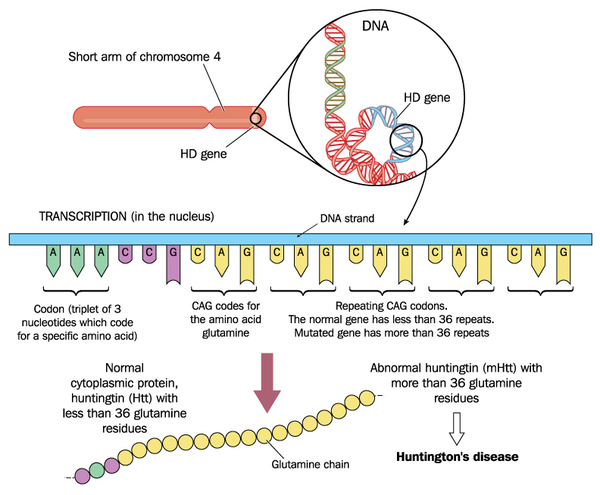
Huntington’s disease:
- It is also known as Huntington chorea
- It is one of rare and fatal diseases that accounts for the gradual breakdown of brain cells or neurons.
- It has a wide effect on person’s physical movements, emotions and cognitive behavior.
- The symptoms for this disease can occur at any time, but they are often seen at the age of early 30s or 40s. In case the condition appears before age 20, it is referred as juvenile Huntington’s disease (HD). This state tends to progress more rapidly than the adult onset form, affected individuals usually live 10 to 15 years after signs and symptoms are prominent.
- Medications are obtainable for the control of symptoms of Huntington’s disease. But there is no complete cure for the physical, mental and cognitive decline linked with this condition.
- Every individual possess gene that causes HD, but only those who are capable for taking over expansion of that gene will develop HD.
- HD is also well known as autosomal dominant disorder i.e. an individual requires only one copy of the faulty gene to develop the disease.
- It is also termed as quintessential family disorder as each child of a parent has 50% chance of inheriting the defective gene.
Causes:
- HD is caused by a mutation in HTT gene on chromosome number 4.
- HTT gene is the ‘interesting transcript 15’ (IT15) gene which code for huntingtin protein, this protein has no any known function but it is believed to play a vital role in neurons in the brain.
- The genetic mutation for HD is unlike other mutations, i.e. instead of substitution or deletion of gene, there is copying default, i.e. an area within the gene gets copied too many times.
- The HTT gene consists of CAG trinucleotide repeats (cytosine, adenine, and guanine) at 5’ end that occurs multiple times in a row.
- Generally, the CAG sequence is repeated 10-35 times within the gene, but in the people with HD disorder the repetition is seen as 36 to >120 times.
- As CAG code for glutamine. This abnormal increase in the length of CAG segment yields to the huntingtin protein with an unusually long polyglutamine sequence.
- This resulted protein is now cut and smaller fragments so formed are toxic in nature which gets accumulated in neurons, damaging the normal functions of these cells.
- The abnormality and eventual death of nerve cells in specific areas of brain form the root for signs and symptoms of HD.

Symptoms:
The signs and symptoms vary according to the individuals. But, the symptoms can be classified as:
- Early stage
- The middle stage
- The late stage
1. Early signs and symptoms:
- Frequent irritation
- Mood swings
- Lack of proper concentration during work
- Short term memory loss
- Melancholy
- Loss of balance and inability to gain proper posture.
- Lethargic appearance
2. The middle stage symptoms:
- The situation becomes more severe and it includes physical, mental and cognitive changes.
- Physical changes:
- Loss of appetite, weaker appearance
- Dysphasia, and stuttering
- Dysfunctional diaphragm resulting difficulties in swallowing.
- flicking of arms, legs
- jerking of face or head
- Emotional changes:
- Misanthropic behavior
- Aggression
- Annoyance
- Lack of interest
- Stubbornness
- Frequent disappointment
- Cognitive changes:
- Loss of orientation
- Difficulties in multitasking
- Lack of creativity
3. The late stage symptoms
- Ultimately, the person will no longer be capable to move or dictate and will seek full nursing care.
- HD isn’t fatal on its own, but choking, pneumonia, weight loss or other infection can be.
Diagnosis of Huntington’s disease
- Various laboratory and clinical tests are performed for the diagnosis.
- It includes neurological tests, genetic tests, brain function tests and psychological tests.
- Neurological tests: It include eyesight, hearing, sense of touch, control, stability etc.
- Brain function tests: It include electroencephalogram (EEG) to measure electrical activity in brain, imaging tests such as Magnetic resonance imaging (MRI) to record brain images, and Computed tomography (CT) scans to produce cross sectional image of brain.
- psychological tests
- Genetic tests: Genetic tests are done to confirm the diagnosis.
Treatment:
- Medications and therapies are recommended for the control of symptoms of HD.
- Medications are likely to provide relief from some physical and mental dystrophies.
- Tetrabenazine and anti-psychotic drugs can treat involuntary movements.
- Diazepam, clonazepam, haloperidol, clozapine are drugs prescribed for movement controls and hallucinations etc.
- Fluoxetine, sertraline, nortriptyline are drugs for depression.
- Lithium can be useful for tremendous emotions and mood swings.
- Speech therapy deals with the patient’s ways to express words and phrases and help in a more effective way.
- Physical therapy helps to refine balance and co-ordination and occupational therapy helps the patient to deal with concentration and memory related issues.
- Psychotherapy is useful for mental and emotional issues.
References
- https://www.medicalnewstoday.com/articles/159552#diagnosis
- https://www.healthline.com/health/huntingtons-disease#treatments
- https://ghr.nlm.nih.gov/condition/huntington-disease#diagnosis
- https://www.mayoclinic.org/diseases-conditions/huntingtons-disease/symptoms-causes/syc-20356117
